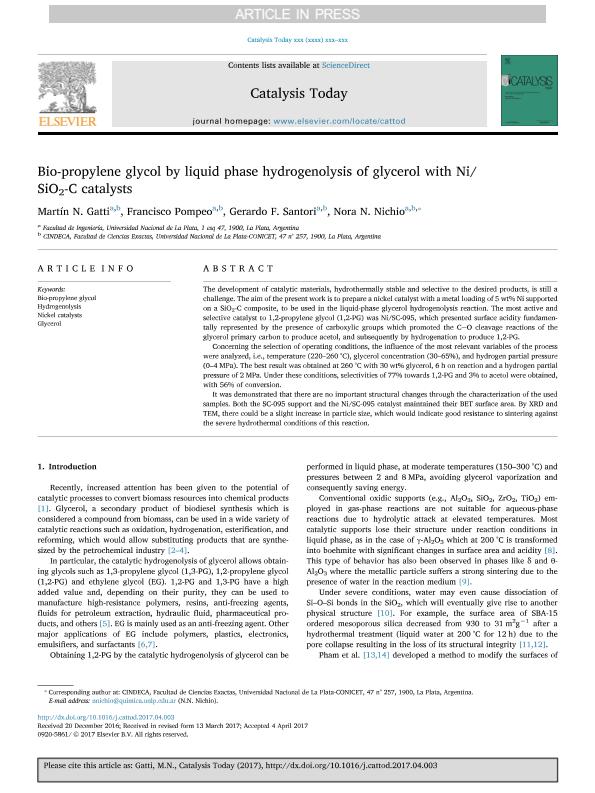Artículo
Bio-propylene glycol by liquid phase hydrogenolysis of glycerol with Ni/SiO2-C catalysts
Fecha de publicación:
04/2017
Editorial:
Elsevier Science
Revista:
Catalysis Today
ISSN:
0920-5861
Idioma:
Inglés
Tipo de recurso:
Artículo publicado
Clasificación temática:
Resumen
The development of catalytic materials, hydrothermally stable and selective to the desired products, is still a challenge. The aim of the present work is to prepare a nickel catalyst with a metal loading of 5 wt% Ni supported on a SiO2-C composite, to be used in the liquid-phase glycerol hydrogenolysis reaction. The most active and selective catalyst to 1,2-propylene glycol (1,2-PG) was Ni/SC-095, which presented surface acidity fundamentally represented by the presence of carboxylic groups which promoted the CO cleavage reactions of the glycerol primary carbon to produce acetol, and subsequently by hydrogenation to produce 1,2-PG. Concerning the selection of operating conditions, the influence of the most relevant variables of the process were analyzed, i.e., temperature (220–260 °C), glycerol concentration (30–65%), and hydrogen partial pressure (0–4 MPa). The best result was obtained at 260 °C with 30 wt% glycerol, 6 h on reaction and a hydrogen partial pressure of 2 MPa. Under these conditions, selectivities of 77% towards 1,2-PG and 3% to acetol were obtained, with 56% of conversion. It was demonstrated that there are no important structural changes through the characterization of the used samples. Both the SC-095 support and the Ni/SC-095 catalyst maintained their BET surface area. By XRD and TEM, there could be a slight increase in particle size, which would indicate good resistance to sintering against the severe hydrothermal conditions of this reaction.
Palabras clave:
Bio-Propylene Glycol
,
Hydrogenolisis
,
Nickel Catalysts
,
Glycerol
Archivos asociados
Licencia
Identificadores
Colecciones
Articulos(CINDECA)
Articulos de CENTRO DE INV EN CS.APLICADAS "DR.JORGE J.RONCO"
Articulos de CENTRO DE INV EN CS.APLICADAS "DR.JORGE J.RONCO"
Citación
Gatti, Martin Nicolas; Pompeo, Francisco; Santori, Gerardo Fabian; Nichio, Nora Nancy; Bio-propylene glycol by liquid phase hydrogenolysis of glycerol with Ni/SiO2-C catalysts; Elsevier Science; Catalysis Today; 296; 4-2017; 26-34
Compartir
Altmétricas




